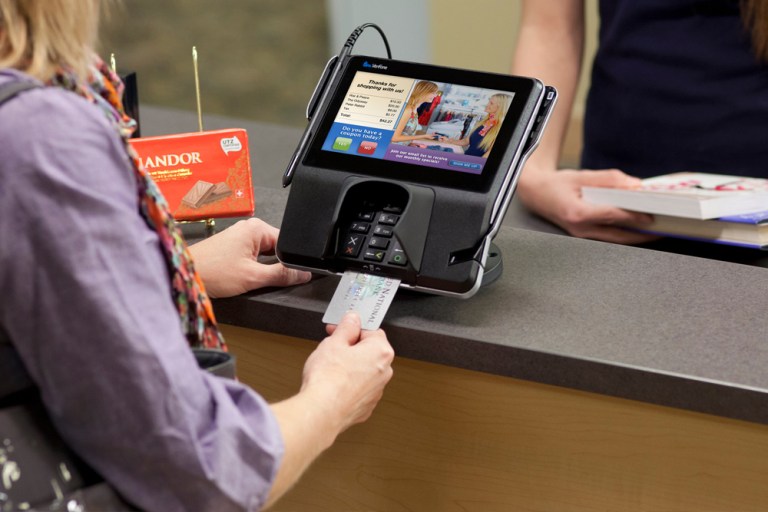
Verifone is in the midst of moving beyond the terminal to embrace commerce driven by software. In meeting 1Q Street results, Verifone CEO, Paul Galant, said that the double digit growth in service revenues, prove that investments in commerce and the cloud are reaping big returns.
Verifone reported first quarter results that largely met expectations, driven in part by a shift to services, while management pointed to execution on strategic priorities tied to the current fiscal year.
Earnings per share came in at 23 cents, while revenues of $436.8 million were off 3.8 percent, roughly in line with consensus.
On the conference call with analysts, CEO Paul Galant said the company is charting a path to growth, marked by recent results.
In addition to reaffirming fiscal year targets, said the executive, systems revenue declined as expected versus last year.
“Excluding the headwinds brought on by the North America Petro EMV push-out and last year’s terminal sale surge in India, the remaining systems business revenue grew [by] double digits year-over-year in the period.” He called out services, up 11 percent year-over-year.
Overall, services were 43 percent of total revenue in the quarter – and it is services and a push beyond hardware (and the terminal) that will drive a return to growth, said the CEO.
In reference to next-generation devices, the company delivered 7 percent of total system sales from newer products and is on track to generate 15 percent from that pantheon, such as Engaged, Carbon and mobile point-of-sale devices.
“In Q1, our suite of new products became available for sale in more than half of our top 20 revenue-producing markets for Verifone,” said Galant. “By the end of the year, we expect to penetrate most of these remaining countries.
“Specific to the Carbon pipeline, we are completing several important certifications [for] acquirers to begin pilots and distribution into their vast merchant ecosystems,” he continued. “We have also started to execute directly with the ISO channel, which will extend Carbon further downstream into Tier 3 and Tier 4 merchants.”
Galant pointed specifically to the Paysafe partnership: “We recently announced an important new partnership with Paysafe for obtaining this initiative. Paysafe, which is a very large ISO, will white-label our Verifone Connect services platform and will offer Carbon and Engage solutions to their large merchant base of SMB clients in North America.”
mPOS continues to grow by double digits, he said.
Discussing the goal to connect more of the 30 million devices out in the field through gateways and estate management solutions to Verifone Connect, the cloud-based platform, Galant told analysts that it is nearly at its stated goal of two million devices through the end of this year.
“Our third strategic priority is to enable our merchant’s acquirer bank and ISO and ISV clients to serve their merchants with our Verifone Connect services platform,” added Galant, recounting the launch of Verifone Connect at the NRF show earlier this year. “We remain on track to launch our highly advanced application marketplace during the second half of the year, featuring vertically curated proprietary and third-party merchant productivity and consumer-facing experience applications.”
The movement to embrace recurring revenue, according to the firm, can bring significant returns, even measured on a per-device level. Galant stated that in fiscal 2017, Verifone generated more than $500 million in recurring services revenue.
“In Q1, this base grew 13 percent year-over-year. We think Verifone Connect can help us to further accelerate this growth by increasing subscription-based payments, commerce and omnichannel services that collectively have better margins than our services business as a whole,” he said.
CFO Marc Rothman noted that North American Petro sales were up 9 percent. He said that in North America, “growth in our retail vertical came as a result of our leadership position with QSRs, robust demand for mPOS devices, as well as refresh business with the earliest Tier 1 retail adopters of EMV. We’ve also continued expanding our Verifone Connect offering into new verticals, accelerating the pace of new subscriptions. Meanwhile, our SMB vertical grew by more than 20 percent year-on-year for the second straight period. For its part, we believe Petro has leveled off, and we expect to begin with slight sequential growth into Q2.”
There was also growth in the double digits across Latin America, spurred by Brazil, said Rothman.
He said services growth was driven by improved services mix in North America, reflecting better overall performance across all regions.
Later in the call, said Galant, in response to analyst questions, “the way we go to market is going to be Verifone Connect, and it has already four components. It’s got device services, it’s got payment services, it’s got commerce services and it’s got omnichannel services … a significant portion that is recurring in nature.”
In response to analyst questions about North America, Galant said that “the focus of Engage and Carbon is primarily at the SMB and greenfield, where we think [there are] 5 million devices that still need to be upgraded.” He noted the April 2018 liability shift date, which is supposed to put the liability on merchants who don’t upgrade to EMV as a catalyst.
Speaking about the global opportunity for terminals and payment services tied to accepting payments, that market, Rothman said, is “in the $60 billion range, give or take.” Business services would double that total addressable market, he added.